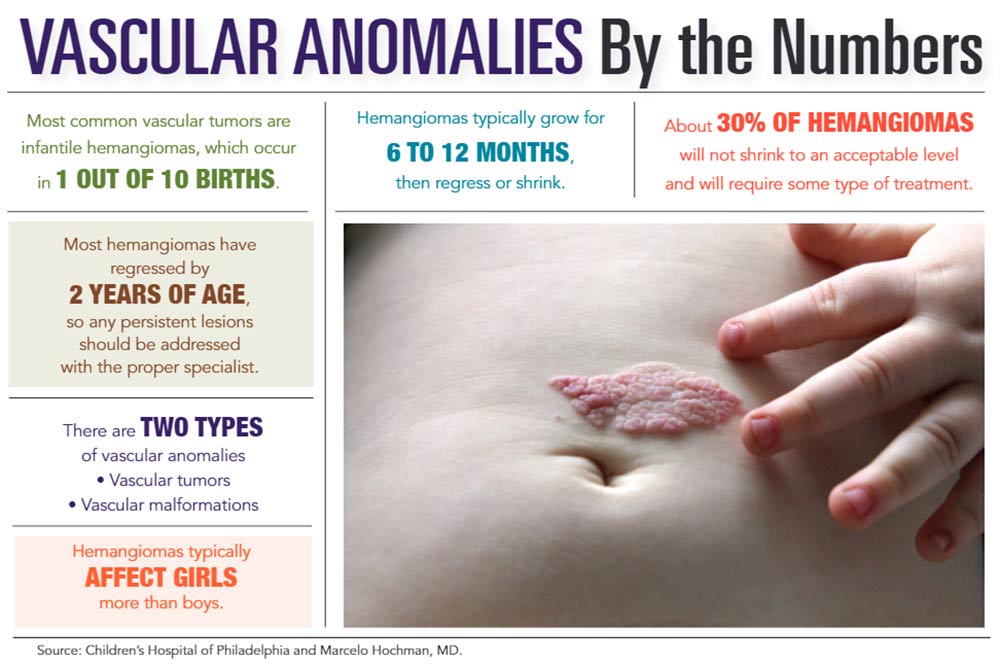Counting fingers and toes, taking stock of the new little one’s weight and length, documenting eye and hair color – these are all tasks that parents of a newborn revel in accomplishing shortly after delivery. And for most, the moment they first lay eyes on their baby leads to a sigh of relief at the realization that the child is healthy and free of any noticeable birth defects.
Unfortunately though, clear skin on delivery day doesn’t always equate to a clean bill of health for the newborn. According to Marcelo Hochman, MD, facial plastic and reconstructive surgeon with the Hemangioma & Malformation Treatment Center in Charleston, the visible evidence of some birth defects – infantile hemangiomas, a frequently occurring type of vascular tumor, for example – may not be readily identifiable until several weeks after a baby is born.
“There are two types of vascular anomalies: vascular tumors and vascular malformations,” Dr. Hochman said. “The most common type of vascular tumors are hemangiomas, which typically occur in infancy and generally affect girls more than boys. They are true benign tumors that present as red marks, usually on the head, neck or face.”
Dr. Hochman explained that vascular anomalies impact about 1 in 10 infants and, due to their unusual growth and regression patterns, it is important for parents to be vigilant and report any changes as soon as possible to their baby’s pediatrician.
Dr. Lara Wine Lee, director of pediatric dermatology and medical director of the Vascular Anomalies Group at the Medical University of South Carolina, agreed.
“In cases like these, it is crucial for parents to see a doctor right away if they notice anything abnormal during their baby’s development,” Dr. Wine Lee said. “With vascular anomalies, often times what might be brushed off as just a common birthmark could, in fact, be something much more serious. Your child’s pediatrician will be able to refer you to a specialist who can effectively diagnose, treat and monitor the progression of an anomaly. Really, the sooner the better.”
According to Dr. Wine Lee, certain types of vascular tumors or malformations can sometimes be detected while the baby is still in the mother’s womb, speeding up the diagnosis process and alerting physicians to potential complications during delivery.
“It is possible for an anatomical scan accomplished at or around the 20-week gestation mark to show an anomaly if it is large enough,” she said. “In the event of a prenatal diagnosis, the correct specialists can become involved early and delivery can occur at a medical facility equipped to immediately respond to any problems at birth.”
Infantile hemangiomas will typically appear shortly after birth and then grow for six to 12 months before beginning to shrink, or regress. According to Dr. Hochman, all hemangiomas will shrink to some degree over some period of time, however, up to 30% of these tumors will not regress to an acceptable level and will require some sort of treatment. Dr. Hochman, who has 20 years of experience treating vascular anomalies, cautioned that most hemangiomas have regressed by 2 years of age, so any persistent lesions should be addressed with the proper specialist.
“Size, location, stage – whether growing or regressing – and the age of the baby all come into play in deciding what kind of treatment may be necessary,” said Dr. Hochman. “As you might expect, the threshold for acceptance of any abnormality on the face is lower than other areas of the body. Additionally, a tumor or malformation near the eye could affect vision, while a rapidly growing anomaly can cause the skin to break, resulting in a problematic open wound.”
Treatment options range from medications, like beta blockers, in the early stages to laser therapy to reduce redness and eventually surgical removal in some cases, among other procedures.
“Each one of these cases is unique,” Dr. Wine Lee said. “That’s why it’s so important to have the proper medical care with a multidisciplinary team. The care plans evolve with the patient over time, and this reduces a lot of anxiety for the parents and, as they age and become more aware, the child, too.”
Early treatment with the right specialists can also have a significant impact on the child’s psychosocial development. According to Dr. Hochman, whose vascular anomalies clinic sees about 20 patients each week, children begin to develop a sense of self-image at about the age of 2-and-a-half or 3 years old.
“This is more than a cosmetic concern for the child,” Dr. Hochman explained. “When they are toddlers, children begin to recognize themselves in the mirror and become more aware of any perceived differences. This can have a huge impact on their self-esteem, which is why we stress the importance of addressing these anomalies and mitigating them as much as possible before the child reaches school age.”
“It’s best to start a relationship with your doctor early on,” Dr. Wine Lee continued. “Even if the anomaly isn’t functionally limiting or painful, you can share with your doctor your worries and concerns and develop a plan based on what’s important to you and your child long-term.”
By Meredith A. Hagen









